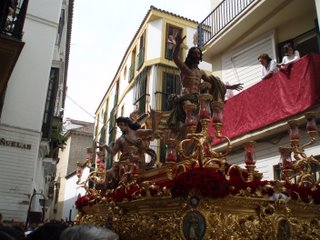There’s a forgotten stairway at the University of Seville that is protected by a metal detector and a couple of guards. Now I understand why.
They guard the Parainfo room, a lecture hall for distinguished guests that’s carpeted and has cushioned red velvet theater-style chairs, long red curtains, and big paintings of famous people. In front is a long wooden desk like one might see in the dining hall at Hogwarts, but today instead of Dumbledore sat the director of my study-abroad program, an important school official, a man from the government (minister of culture I believe) and a few others who looked important – all four wearing formal black or black suits. To their left sat a grey, slightly overweight bored-looking man in a light blue polo shirt – Raúl Rivero.
Before I got involved with this magazine más o menos I didn’t know who he was either. And I still won’t lie and say I completely understand what he stands for. Basically, he’s a journalist and poet from Cuba who was jailed for 20 years for reporting the truth for several U.S. newspapers during the time when he, as a Cuban citizen under Fidel Castro or just during and after the revolution, didn’t have the right to free speech. Now he writes for
El Mundo, one of the more neutral national newspapers in Spain, in Madrid, because he was exiled from Cuba, of course, for writing. “Charla con Raúl Rivero.” Interesting.
So the university official and government official started off the afternoon giving long speeches about his accomplishments as at any lecture. I won’t lie again and say I really understood anything of what they said, partly because I ran in a bit late and was trying to get settled and skim the folded papers I was handed as I sat down. After the intro a few people from the audience started standing up and reciting passages from little pieces of paper in fast Spanish, while the audience clapped. I didn’t really I understand them either, but I clapped along because I thought they were the final straw in the kick-off to Raúl, reciting his poems or something. Some of them seemed nervous and shaking as they spoke.
But after several of these recitals it became evident that this wasn’t planned and the officials at the wooden desk started yelling though the microphone to regain order and continue the talk. But the audience continued their reciting and their clapping. They stood up with posters and chanted and kept yelling over the people with the microphones, rejecting any suggestion to stop and talk. Chanting, posters, clapping, yelling, a group at the front of the room held up white painted sheets and a flag with their messages in bold capped letters. The 30-plus people in the audience continued their yelling until the officials gave up at trying to continue the lecture and ushered Raúl and the rest of the bewildered, angry, scared, disappointed audience out of the room.
The group was pro-revolution, whereas Raúl is pro-free speech, the group thinks Raúl is an agent for the CIA and demands that the United States free the five Cubans from the revolution that are still locked in Guantanomo Bay.
There was one part of the protest, when the anti-US energy was particularly high and the yelling of the university official was particularly instant and the protestors were particularly angry and defiant with their claps and yells and posters that I thought there was a possibility that someone would do something violent. I looked around at the audience of black and dark brown wavy-haired Spanish heads and wanted to run out of the room or hide my golden brown hair and pony tail – so obviously the enemy. And even though I’m not always proud of my country and the things we do and the way people act, it was still diminishing and powerful and scary as hell for a room full of yells in Spanish to be directed at you, your friends, and your family. Or if not them, at least the law of the land they all reside.
I don’t even understand what you’re saying, the history behind the conflict, the facts… but I understand that your posters are anti-US and pro-socialism and pro-revolution and there are no security guards nearby and you won’t shut up – I don’t know what you’re going to do next.
My friend claims that when the situation first started getting out of hand Raúl said into his microphone (in Spanish of course), “I didn’t go to prison for 20 years for nothing. Let them speak.” But nonetheless, he didn’t speak, and
El Mundo reported the next day that this is only the third time in the history of the university that someone hasn’t been able to speak – the other two were during Franco and the Inquisition.
Free speech is the freedom that permits me to do what I do, to write on this blog and publish it internet-wide, to write new for my school newspaper, to write for this magazine… but that doesn’t stop the fact that I was scared out of my mind at the simple, random, loud oral expression of it directed against the US.







